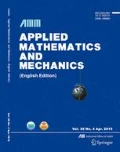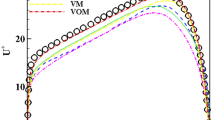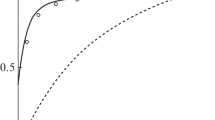Abstract
A new Reynolds stress constitutive formula is constructed using the first-order statistics of turbulent fluctuations instead of the mean strain rate. It includes zero empirical coefficients. The formula is validated with the direet numerieal simulation (DNS) data of turbulent channel flow at Re τ =180. The Reynolds stresses given by the proposed formula agree very well with the DNS results. The good agreement persists even after the multi-angle rotation of the coordinate system, indicating the rotation invariance of the formula. The autocorrelation of the fluctuating velocity rather than the mean strain rate is close to the essence of the Reynolds stress.
Similar content being viewed by others
References
Gatski, T. B. and Jongen, T. Nonlinear eddy viscosity and algebraic stress models for solving complex turbulent flows. Progress in Aerospace Sciences, 36(8), 655–682 (2000)
Craft, T. J., Launder, B. E., and Suga, K. Development and application of a cubic eddy-viscosity model of turbulence. International Journal of Heat and Fluid Flow, 17, 108–115 (1996)
Craft, T. J., Launder, B. E., and Suga, K. Prediction of turbulent transitional phenomena with a nonlinear model. International Journal of Heat and Fluid Flow, 18, 15–28 (1997)
Suga, K. and Abe, K. Nonlinear eddy viscosity modelling for turbulence and heat transfer near wall and shear-free boundaries. International Journal of Heat and Fluid Flow, 21, 37–48 (2000)
Abe, K., Jang, Y. J., and Leschziner, M. A. An investigation of wall-anisotropy expressions and length-scale equations for non-linear eddy-viscosity models. International Journal of Heat and Fluid Flow, 24(2), 181–198 (2003)
Abe, K. An improved anisotropy-resolving subgrid-scale model with the aid of a scale-similarity modeling concept. International Journal of Heat and Fluid Flow, 39, 42–52 (2013)
Ohtsuka, T. and Abe, K. On the role of an anisotropy-resolving extra term for a subgrid-scale model in near-wall turbulence. Journal of Computational Science and Technology, 7(3), 410–425 (2013)
Gerolymos, G. A., Lo, C., Vallet, I., and Younis, B. A. Term-by-term analysis of near-wall second-moment closures. AIAA Journal, 50(12), 2848–2864 (2012)
Wallin, S. and Johansson, A. V. An explicit algebraic Reynolds stress model for incompressible and compressible turbulent flows. Journal of Fluid Mechanics, 403(1), 89–132 (2000)
Durbin, P. Separated flow computations with the k-ɛ-v 2 model. AIAA Journal, 33(4), 659–664 (1995)
Gao, G. and Xu, J. L. A partial average based study of compressible turbulent flows. International Journal of Mechanic Systems Engineering, 3(1), 20–35 (2013)
Gao, G. and Yong, Y. Partial-average-based equations of incompressible turbulent flow. International Journal of Non-Linear Mechanics, 39(9), 1407–1419 (2004)
Gao, G., Zhang, C. X., and Yan, W. H. Numerical study of compression corner flow field using Gao-Yong turbulence model (in Chinese). Journal of Aerospace Power, 27(1), 124–128 (2012)
Gao, G., Jiang, L., and Gao, L. Calculation of wing-body junction flow using Gao-Yong turbulence equations (in Chinese). Journal of Aerospace Power, 38(10), 1271–1274 (2012)
Gao, L., Gao, G., and Jiang, L. Numerical simulation of separated turbulent flow using Gao-Yong turbulent model (in Chinese). Journal of Aerospace Power, 39(5), 1–5 (2013)
She, Z. S., Hu, N., and Wu, Y. Structural ensemble dynamics based closure model for wall-bounded turbulent flow. Acta Mechanica Sinica, 25(5), 731–736 (2009)
Author information
Authors and Affiliations
Corresponding author
Additional information
Project supported by the National Natural Science Foundation of China (No. 11002014)
Rights and permissions
About this article
Cite this article
Xu, J., Tu, Z. & Hu, N. Rotation invariant constitutive relation for Reynolds stress structure parameter. Appl. Math. Mech.-Engl. Ed. 36, 517–522 (2015). https://doi.org/10.1007/s10483-015-1927-9
Received:
Revised:
Published:
Issue Date:
DOI: https://doi.org/10.1007/s10483-015-1927-9




